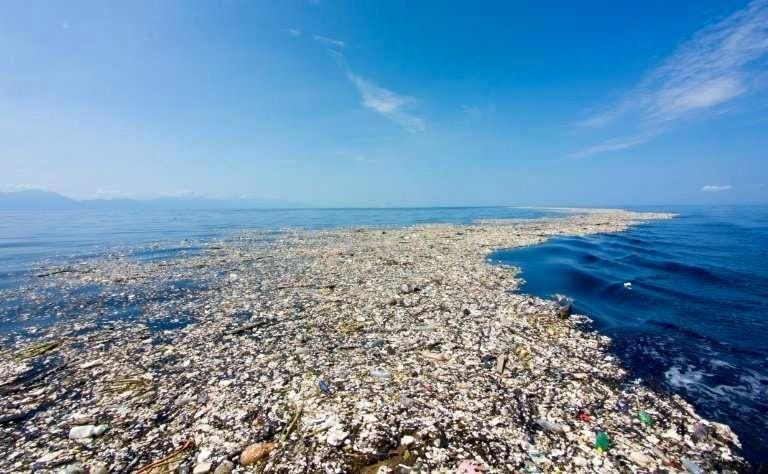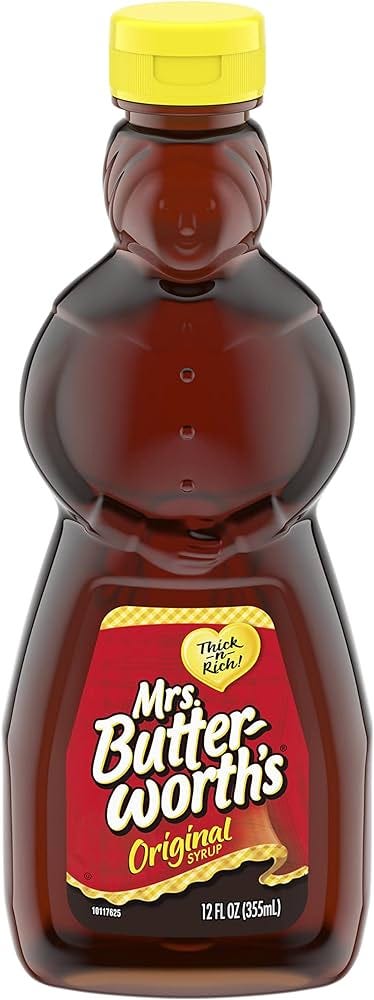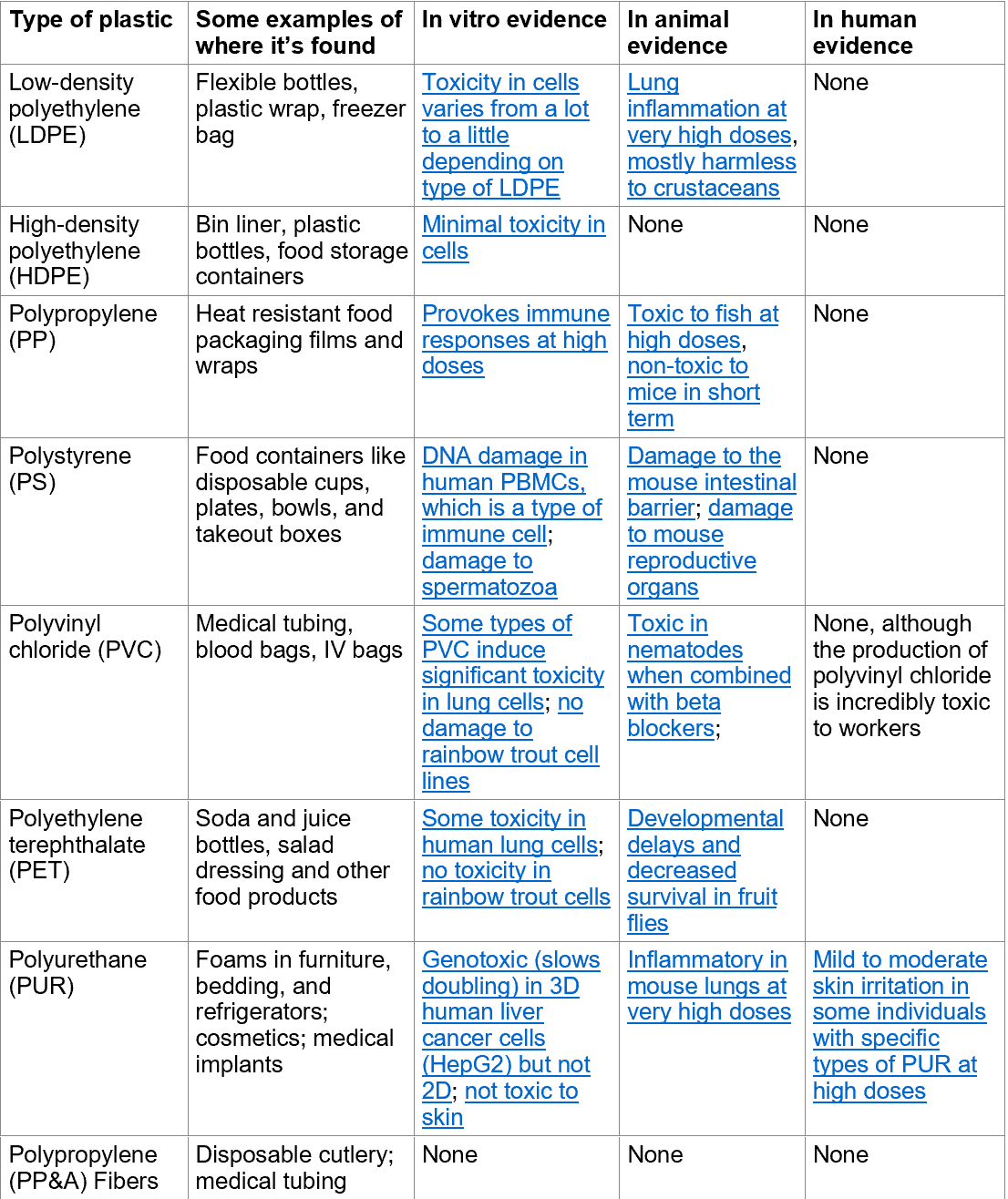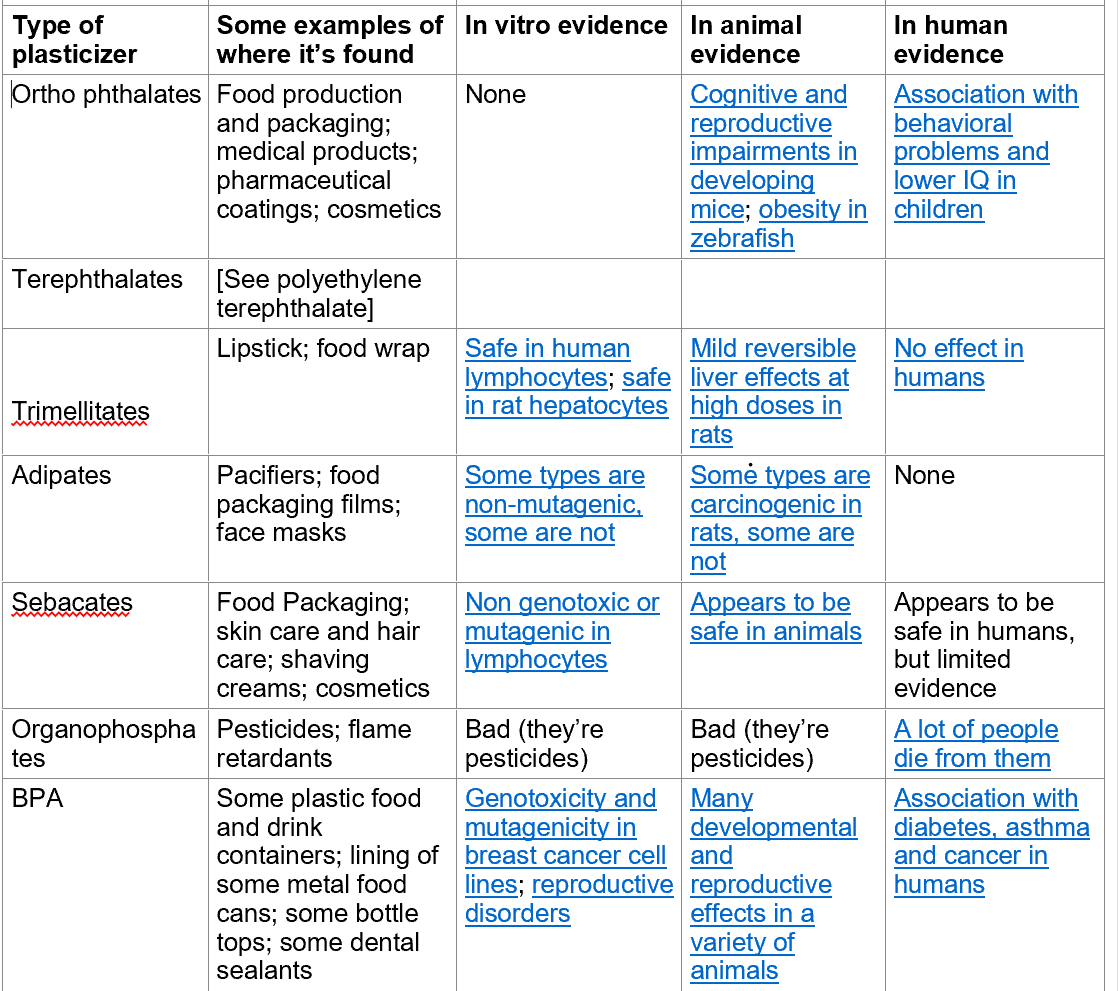Intro to the safety of microplastics
I saw this toxicology study the other day about microplastics being found in dog and human testicles. In the study, they examined the testicles of 23 autopsied men and 47 neutered dogs in New Mexico, and found that all of them had small bits of plastic in their testicles. This study drew a lot of media attention, like this piece from NPR.
In the NPR piece, they do the typical science journalism thing, and get some quotes from the study authors and other scientists to put the findings in context, as well as bring in brief references to other, similar studies. And, of course, one of the most basic context-finding questions NPR asks is, “This is bad, right?” But, instead of the confident answer one might hope for, like “Yes,” or “Definitely,”, the article features quotes like:
“What [microplastics] do in the body, we don’t know,” says Campen, a professor at the UNM College of Pharmacy and one of the authors of the study, “Obviously, little tiny particles can disrupt the way cells behave.”
A correlation [emphasis mine] between lower sperm count in the dog testicles and the presence of PVC
An association [emphasis mine] between greater levels of PVC and decreased weight of the testicles
Microplastics were “suspected” to harm sperm quality and testicular health, but … that may soon tip over from “suspected” to “likely”
We don’t know the clinical ramifications of that yet.
“I think there have to be a lot of caveats saying this is really the beginning,” says Swan, a professor at the Icahn School of Medicine at Mount Sinai, “It’s suggestive, it’s important, and it’s preliminary.”
This is not exactly the confident language one is looking for from health professionals! It’s like a crime article about how cops found a smoking gun, but can’t prove there’s been a murder, and the cops can only discuss how the smoking gun would definitely be a big deal if someone has, in fact, died.
So, what’s the deal with these unconfident statements? Do the scientists quoted all suffer from a lack of confidence? Are they all in the pocket of big plastic/testicle? How do we get to the point where we can actually say for sure that plastic in our testicles is bad?
Well, join me on a magical journey as we discuss:
1) how we determine the safety of chemicals in general
2) how that applies to microplastics
3) how to establish actual knowledge about microplastic safety
4) What we actually know about microplastic safety
How safety is actually measured
It’s no mystery why we don’t know whether microplastics are safe. Determining safety is really hard. Human history is filled with stories of chemicals that we thought were safe but weren’t, like asbestos, or chemicals we thought were dangerous but are actually relatively safe, like cholesterol. The real mystery is how we accurately determined the safety of any chemical at all.

Determining whether a new chemical (or old chemical that was never tested) is safe is hard, expensive, and difficult ethically. This is doubly so for something like microplastics, where the safety concerns mostly come in the form of worrying about the long term systemic effects. We as a society are spoiled by the high quality safety information we get about chemicals like the pharmaceuticals we take, and don’t realize the effort that takes to produce.
Any drug you take, especially a new drug, has had to pass incredibly extensive safety testing1. This is why I get frustrated by people questioning the safety of GLP-1 receptor agonists, because there are very few chemicals in history which have been tested as thoroughly as semaglutide. This isn’t to say that these drugs are completely safe, but it is to say that the costs and benefits of drugs like semaglutide have been extensively measured and argued over and, net-net, they are definitively boons to humanity.
And, similarly, this is why I get so frustrated by people who want to skip safety testing and sell drugs directly to the public (not that any specific drug comes to mind…). The safety of drugs like semaglutide isn’t a happy accident. It’s something that collectively millions of hours and billions of dollars has been spent making possible and establishing. It’s just as stupid to take someone’s untested drug as it is to get in your neighbor’s homemade supercar, and you should take a random drugmaker’s reassurances of n-of-1 safety as seriously as you take your neighbor’s reassurance of “My Frankenvette hasn’t exploded yet”.
Safety testing for drugs, as you might imagine, is pretty formalized. Drugs have to pass roughly this series of safety tests:
1) In vitro toxicology (i.e. does it kill or harm the wrong cells in the petri dish)
2) Two species animal toxicology. This means that the drug has to go through explorations to find the lethal dose of the drug when given for both short and long periods of time to at least 2 species of animal2. Any health issues that come up for non lethal doses are also explored and documented, usually requiring a full clinical histopathology (i.e. testing blood regularly and also cutting open the animal at the end of the tests to examine any damage to their organs)
3) Other animal safety tests, depending on the drug. For example, any drug that might be given to pregnant women will likely be tested on pregnant animals.
4) Safety tests in healthy humans
5) Safety tests in sick humans with the disease
6) Postmarketing surveillance, which means seeing what adverse effects pop up when the drug is given to actual patients based off of doctors’ reports
There are no hard and fast rules about exactly how badly you have to do in one of these tests for your drug to get canceled, but these tests are quite strict3. At the end of all of these tests, if the drug actually ends up on the market, you end up with an enormous amount of information about how these drugs affect the body. You have a really good idea of which safety issues the drug can cause and in what circumstances.
This, to my mind, is a gold standard of what we mean when we discuss whether a chemical is safe. If a doctor (or the FDA) wants to know if semaglutide is safe for pregnant women, they can look through long-term and short-term data on the drug in actual patients, in placebo-controlled trials, in biopsied animals with biopsied fetuses, and in reproductive cells in a petri dish.
Why microplastic safety is hard
Meanwhile, microplastics don’t have that sort of extensive safety data. In fact, they can’t have that data, because “microplastics” is a general term for small pieces of a bunch of different types of plastics (12 in the testicle study) which are blended with plasticizers, additives that change the properties of plastics. So, any given microplastic is a blend of at least two separate chemicals, and there’s no guarantee as to what percentage of each chemical is in the microplastic.
So that’s the first major issue with determining the safety of microplastics: “microplastic” is more of a colloquial term than a scientific term. We should really be talking about the safety of specific types of plastics and plasticizers, just like we talk about the safety of individual drugs rather than drugs as a whole. And, if we want to actually go by FDA safety testing standards as our gold standards, we should really, really be talking about the safety of the plastics alone, the plasticizers alone, and the combination of them in the ratios that would actually be present in the “wild”.

And here’s where you get a sense of why this is so difficult. If we take the 12 types of plastics from the microplastic study, and the 30 most common plasticizers from Wikipedia, we end up having to do at least 400 series of studies to cover just the most common plastics, plasticizers, and combinations of them. Assuming a low preclinical cost of $2 million4, we are talking about $800 million in studies to just get through the animal studies, which would be our most basic studies on the safety of microplastics. And this is assuming we’re just doing our standard 6 month studies. If we’re trying to stretch these studies out longer to see longer term effects, the studies get way more expensive.
But let’s assume we get through these animal studies, and let’s assume we aren’t the FDA, who would shut down any chemical that has the sort of worrying results that some of these plasticizers have in rats (more on those later). After all, if we were the FDA, we’d just have to balance the benefit of a chemical to human health vs. the risk of a chemical to human health, but our job as would-be microplastic regulators is harder than that. We have to balance the benefit of a chemical to the economy vs. the risk of a chemical to human health, which is a tricky calculation to make (maybe). Well, if we get to the point where our microplastics have passed our animal studies, we’d want to move onto human studies.
But we can’t, of course. It’s unethical to intentionally test these plastics in humans. It’s somehow not unethical to unintentionally test these drugs in humans, by using them to package food, but that’s a mystery for the philosophers. And, even if we could test these plastics in humans, getting the sort of data that we’d really want in humans, the long-term data of years of continuous low-level exposure, is basically impossible in our current funding environment. Decade-long studies are very rare nowadays5.
So, given that we don’t have enough money to test the safety all, or most, or even a significant fraction of the plastics, plasticizers, and combinations that are present in the products we consume every day (and in our testicles), and given that we can’t intentionally test these drugs in humans, the data that we do actually have for the safety of microplastics ends up being a poor combination of 1-3 and a weak version of 6. Or, to be more specific, for microplastics and similar chemicals the best we can get is:
1) Whatever in-vitro results have been tested based on educated guesswork
2) Small animal (usually mouse or rat) toxicology with limited pathology, because university labs rarely have the funding or capability to do large animal toxicology or complete clinical pathology
3) Whatever other random small animal trials get done
6) Circumstantial evidence from humans who’ve been exposed to microplastics
It’s definitely not up to our gold standard, in other words. Probably a copper standard at best. So, that’s why we end up with such wishy-washy statements about the actual harm of microplastics.
How to improve the evidence on microplastic safety
I’ve started to notice some interest in microplastics from super wealthy people, which is part of the reason I wrote this post. I think it’s worthwhile to do better research on microplastics, because I think there’s a definite possibility they could be a much more serious health problem than we realize.
Unfortunately, I don’t think this better research will come from the big microplastics project that was just announced, Nat Friedman’s project6. Now, I have a lot of respect for Nat, at least as far as I know him. I think his Scroll project was very cool and well done, and I am hugely in favor of rich people funding science in the public interest. So, this is all meant as a good faith criticism.
Nat’s project is basically about surveying the top 80-100 foods that people want surveyed for microplastics, and then publishing the results. That’s pretty much it, as far as I can tell, along with publishing a review of the existing literature on the safety of microplastics7. Unfortunately, this doesn’t engage with the pre-existing literature, as they say.
Because, in the pre-existing literature, there’s already been a bunch of studies on microplastics in common foods. Just from a quick Google search, I found
1) A big Consumer Reports study of microplastics in 67 grocery store foods and 18 fast foods
2) A study of plasticizers in fast food in San Antonio
3) And a study of plasticizers in a variety of organic and non-organic vegetable oils, dairy, and infant formulae
All of these studies find basically the same thing, which is that there’s a wide range of plasticizer concentrations in common food items, from a lot to none. Now, there are some gaps in this testing literature, like how they mostly focus on phthalates, a specific type of plasticizer, and how the selection of food items to test seems to be random, but, overall, the message seems pretty clear: the food you buy probably has plasticizers in it, which might be bad.
I don’t think Nat’s project can meaningfully contribute to this research. At best, the guys working on Nat’s project might be able to test new foods for additional plasticizers beyond phthalates, which will, I guess, give more evidence as to how the food we buy has plasticizers in it, but that’s not much of a contribution. Knowing that additional food items do or do not have plasticizers in them doesn’t really help us much, given our lack of knowledge about the health effects of consuming plasticizers or plastics.
Instead, I think the real gaps that exist are either further upstream or further downstream. Further upstream, the gaps are more along the lines of why there is such a big variation in plasticizer concentration in foods, like how there are 1000 ng of phthalates in Mrs. Butterworth’s syrup vs. 22 ng of phthalates in Sweet Baby Ray’s BBQ sauce. This is a huge discrepancy of 500x for two similar sized products with similar packaging, and none of the literature seems to have good explanations for it.
If the discrepancy lies in the packaging materials themselves or the packaging process, this presents obvious opportunities for follow-up experiments to try to reduce the levels of phthalates by altering the materials or packaging process. This would also present obvious opportunities for regulatory or grassroots pressure to mandate low-phthalate materials or processes for packaged foods, because the regulation could just be “Do whatever Sweet Baby Ray’s does”, assuming that’s universalizable.
On the other hand, if the discrepancy does not lie in the packaging materials or process, this would also be an interesting result. This would suggest a more fundamental contamination of the food supply with phthalates, like that the corn used to make Mrs. Butterworth’s is already filled with phthalates by the time it’s harvested. This would also be much more disturbing, but, you know, that’s science.
Figuring out why these discrepancies exist and how to test them would, of course, require more expertise than simply blindly testing items. Conagra isn’t likely to be open about how Mrs. Butterworth’s syrup is made, and it’d be impossible to figure it out by just blind guessing. But manufacturing consultants with this expertise exist in the food industry just like they do in the drug industry, and I’m sure they’d love to get paid and be an author on a paper, because that’s not a common opportunity for them. And I’d bet these consultants will have some thoughts already about this discrepancy, because phthalates are probably a well-discussed topic in their meetings. I’m sure it’s not a happy coincidence that Sweet Baby Ray’s has low phthalate levels.

So, the upstream gap is why the discrepancy exists. The downstream gap is, of course, the health consequences of this gap. As I said at the beginning of this piece, there are still a bunch of unanswered questions as to what the consequences of any of this are. It’s definitely not good that Mrs. Butterworth’s secret ingredient is phthalates, but whether that’s a catastrophe on the level of lead in the drinking water is still up for debate.
Barring massive amounts of money for animal testing or a permissive environment for human testing, I think the best case scenario here would be a natural experiment. If there’s some scenario in which people with excellent long-term health records get suddenly exposed to high levels of microplastics, then matching those people with controls could show clearly the health effects of microplastics.
The most obvious place to look for these would be places where people get both prescribed meals and regular health checkups, like prisons, the military, and long-term care. This would, again, require some legwork. Figuring out which facilities serve food with high levels of phthalates or other sorts of microplastics and then working with them to analyze their health data will not be easy, either scientifically or regulatorily (not only because health data is protected, but because this could embarrass or legally endanger the facility in question).
However, this line of research would be very rewarding. This research could give us a clear signal like, “People in the Army consume high levels of phthalates and have high levels of infertility. People who’ve eaten more Army food with phthalates have higher levels of infertility than other soldiers, with infertility starting directly after consumption of phthalates.” This would be a very strong result in the microplastic literature and, again, provide ample fodder for regulators or consumers to demand changes, now that there’s stronger evidence of the actual health damages caused by microplastics.
Now, I get that both of these lines of research would entail greater funding, more expertise, and more time than Nat’s project. They also don’t involve the power of amateur researchers, which Nat’s Scroll project used really effectively and which Nat is kind of involving here by having people vote on which food items to test for microplastics, although that seems mostly like a marketing gimmick. But, you know, science does sometimes take time, money, and expertise. And what’s the point of making tons of money through AI investing if you can’t spend some of it on good science?
The microplastic safety evidence that does exist in table format
Ok, enough about what we could find out. Let’s talk about what we do know. I’ve made a short table below of the known health consequences of the most common types of plastics and plasticizers.
Fair warning: there’s really not much, even for the most common plastics and plasticizers and even when I group plastics and plasticizers instead of breaking them up into their actual chemical formulae. We are unfortunately far, far away from our gold standard of toxicology for each type of plastic, plasticizer, and combination. Also, shout out to Perplexity.AI for making this research easier than I thought it was going to be.
With that being said, here is the table. Please note that these are images, and if you want the links in the images, you’ll have to go to this Google Doc.


There are some older drugs that are grandfathered in and probably would not pass modern safety testing regimes. People often bring up Tylenol as an example of one of these drugs, because acetaminophen, the active ingredient in Tylenol, is very easy to overdose on (literally just double the recommended daily dose, or the equivalent of taking one maximum strength pill per waking hour), overdoses can be fatal and need to be treated at a hospital, and yet it can be bought by children without a prescription.
Another interesting grandfathered drug I came across recently was Afrin, the nasal decongestant. Afrin can be bought over the counter, and yet it becomes addictive in just 3 days of use, in the sense that you will become physically dependent on it to open up your sinuses. People who are predisposed to addiction can also become easily addicted to it in the more classical sense, suffering anxiety that can only be alleviated by more Afrin. You can find some horror stories on Reddit of people whose lives get ruined by addiction to Afrin. Again, it’s unlikely Afrin would pass modern safety testing regimes because of this.
Traditionally, these two species are mice and dogs. This is problematic because dogs, especially, are susceptible to some chemicals that humans are not (e.g. chocolate). This has led to the common drug developers’ complaint, “Drugs kill dogs and dogs kill drugs”. This susceptibility, combined with dogs’ propensity to vomit randomly, has made minipigs increasingly popular as a second species.
Too strict, in my opinion, but that’s an argument for another post.
This is like a minimum to do your basic batch of in vitro studies and in vivo toxicology studies for well-understood small molecules. Specialty testing, like for a new modality, or long-term testing, like for a gene therapy, will be more expensive.
There are a few national health services that might be a good fit for this, like Taiwan’s or Sweden’s, because they collect and publicly analyze their data anyways, but I haven’t seen any studies from them like this. I think the way they work is that they release data that’s already being regularly collected for studies, but they won’t collect new types of data for a study. I could be wrong, though.
Conflict of interest notice: I applied for the project when he just said he needed someone for a microplastics project, which I assumed was going to be a research project similar to this one. I talked to Nat over Zoom, found out what he planned, and sent him an email similar to this section to try to persuade him to do differently, which he didn’t respond to. That encounter, combined with my pre-existing interest in microplastics and this fun plastic testicle study, made me write this post.
He also mentions something about “Stretch goal is to develop ‘Lactaid for microplastics’”. Lactaid, if you don’t know, is a consumable form of the lactase enzyme, which allows lactose-intolerant people to consume lactose products. I’m not sure how serious Nat is about this stretch goal, but, if he is, this really doesn’t make sense. There aren’t any enzymes that can develop microplastics, at least not in humans. They’d have to develop a bacteria that can quickly digest microplastics and then people would consume these bacteria every time they eat food with microplastics, which could be any food. There are a bunch of problems with this, not least of which would be the safety issue of consuming those bacteria. I’m not sure Nat has thought this through.